An international team of astrophysicists has observed strange behaviors in several star clusters, appearing to challenge our current understanding of gravity on a cosmic scale.
Stellar clusters with strange behavior
Although it has since been supplanted by the Einstein’s theory of general relativity, Isaac Newton’s law of universal gravitation has until now been used to explain the structure and large-scale movements of the Universe. In the context of work published in the journal Monthly Notices of the Royal Astronomical Societyscientists have made observations that do not quite match currently accepted models.
The team focused on clusters ofstars open. Consisting of thousands of young celestial bodies that formed from a massive cloud of dust and gas, these celestial objects normally have a short lifespan.
According to the European Space Agency, a cluster tends to lose stars because they are torn between each other under the effect of gravity. The stars moved towards its edges can then end up forming tidal tails (long and fine structures composed of stars and gas appearing on either side of the cluster) under the gravitational influence of the galaxy.

The alternative MOND theory
In order to determine precisely to which tail the different stars of the cluster belonged, the astrophysicists used a new approach called CCP (Jerabkova-compact-convergent-point) and applied it to data from four open star clusters collected by different assignments. To their surprise, the front tails systematically contained many more stars.
” The two tails are supposed to contain roughly the same number of stars, but our observations indicate for the first time that this is not always the case: in the clusters we have studied, the front tail always contained many more stars. stars close to the cluster as the rear tail », underlines Jan Pflamm-Altenburg, co-author of the study.
Pflamm-Altenburg and his colleagues then simulated the movements of stars within these clusters based on an alternative model. Known as ” modified Newtonian dynamics (MOND), this one essentially suggests that the effects of gravity are stronger at low levels of acceleration than predicted by Newton’s laws. Strikingly, these predictions were found to closely match the observations made.

Huge potential implications
” The MOND model predicts that stars can leave a cluster through two gates, leading to the back and front tidal tail respectively “, explains Pavel Kroupa, lead author of the study. ” Contrary to Newton’s theory of gravitational attraction, where they have the same width, the first door turns out to be much narrower than the second, implying a lower probability that a star leaves the cluster by borrowing it. »
Researchers are currently exploring other methods to produce more accurate simulations, which could then be extended to other astronomical objects to confirm the validity of the MOND theory. Which could potentially upset astrophysics as we know it.
Currently, the dominant theory to explain the discrepancies in the observed motion of stars and galaxies, which seem to move much too quickly compared to their apparent mass, is that of the black matter, invisible. But despite decades of hunting, the hypothetical particles composing it have never yet been detected.
We would like to say thanks to the author of this article for this awesome material
Puzzling Astronomical Observations Support an Alternative Theory of Gravity
You can view our social media profiles here , as well as additional related pages here.https://nimblespirit.com/related-pages/

